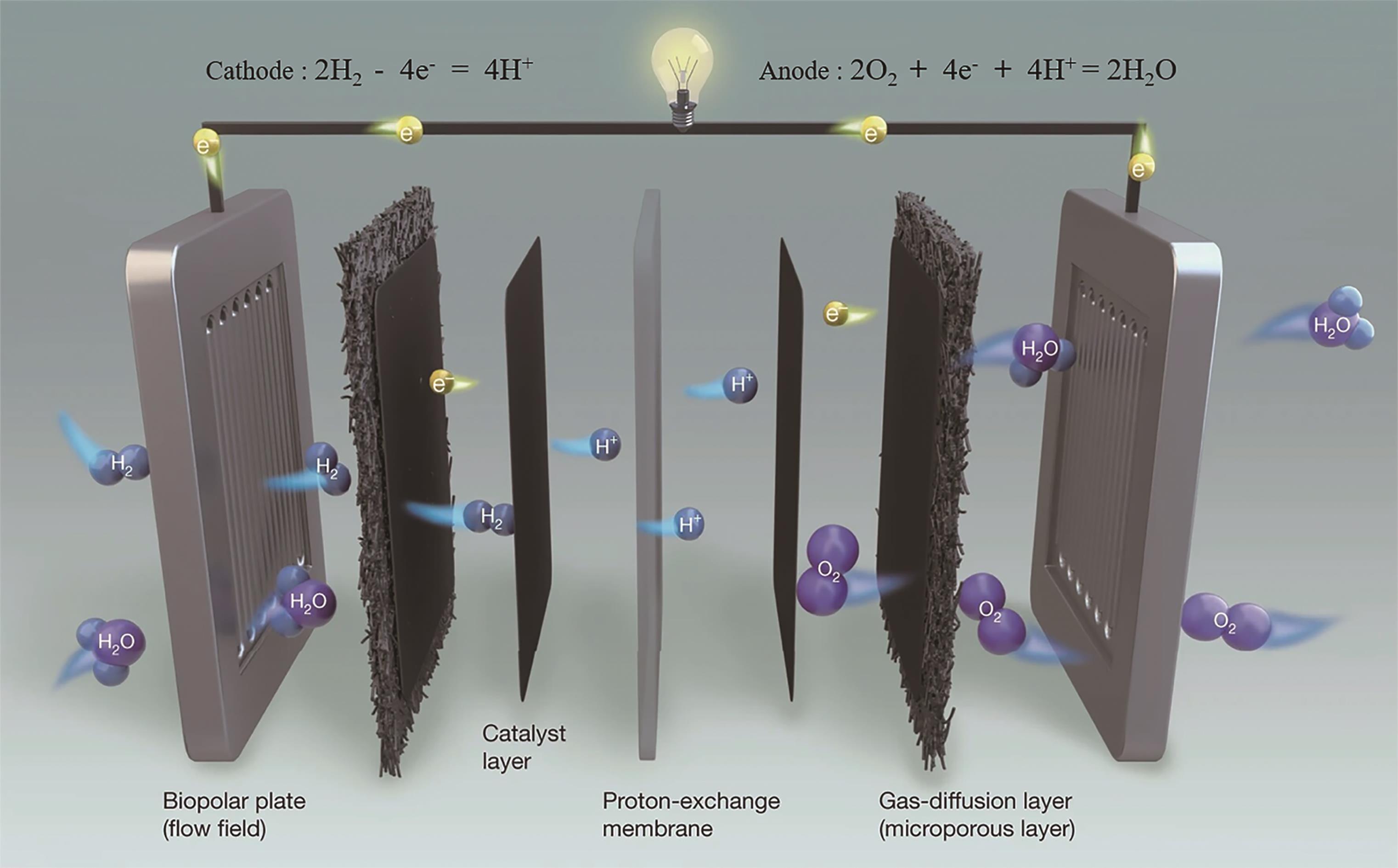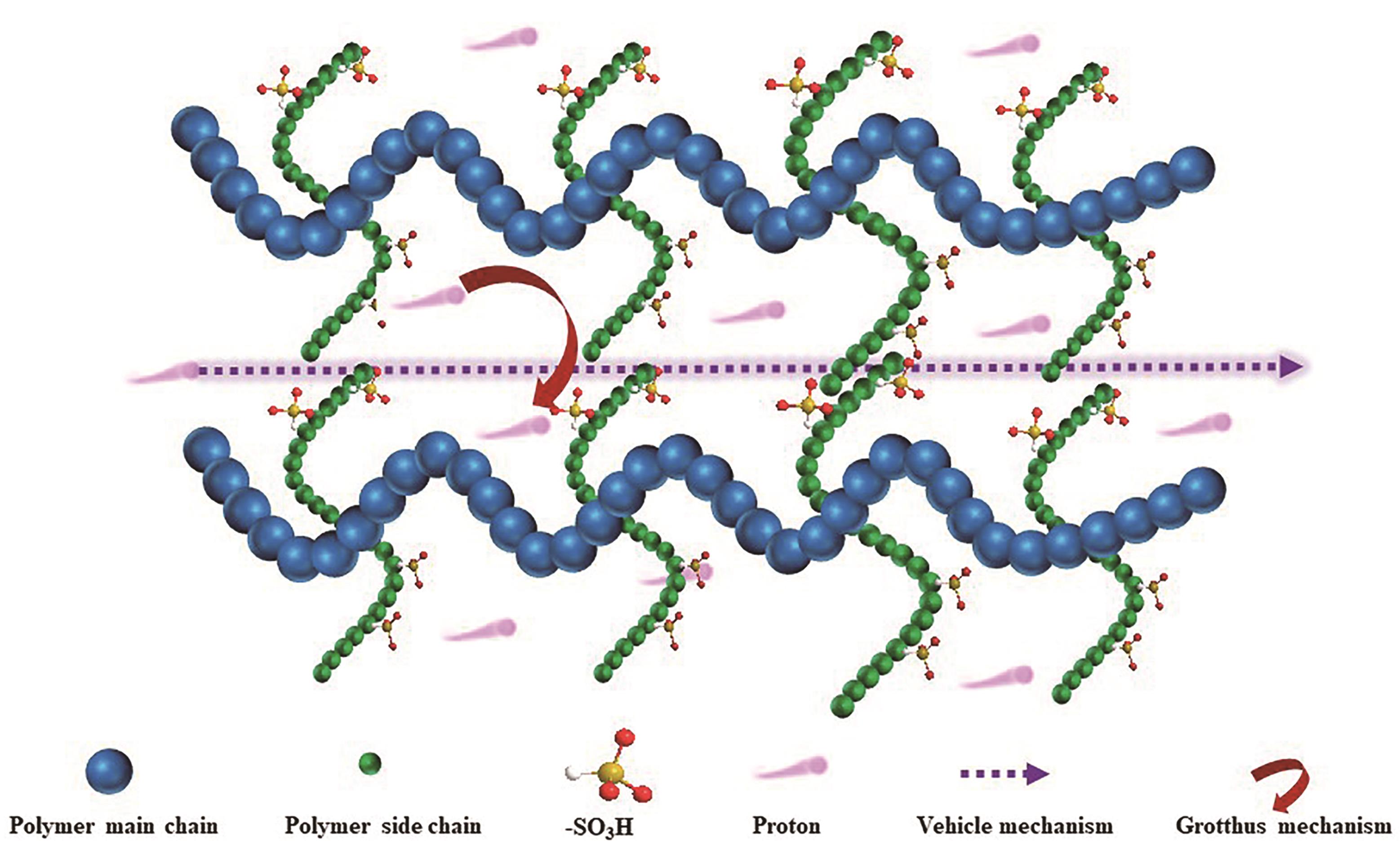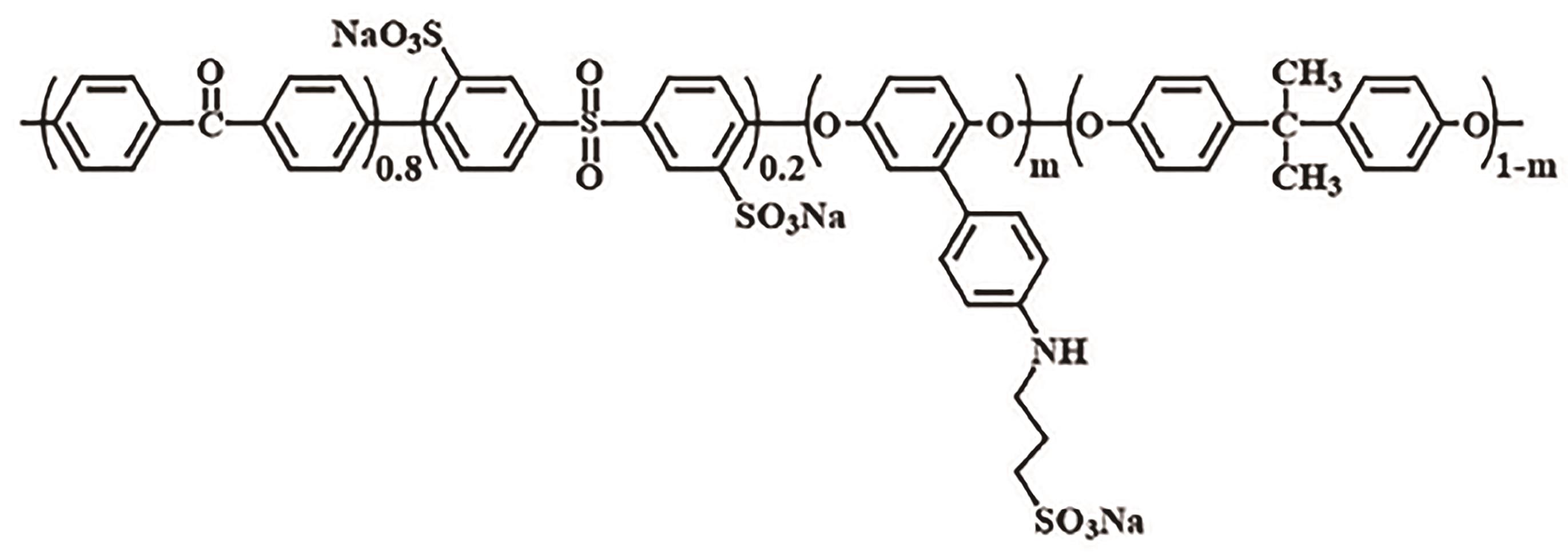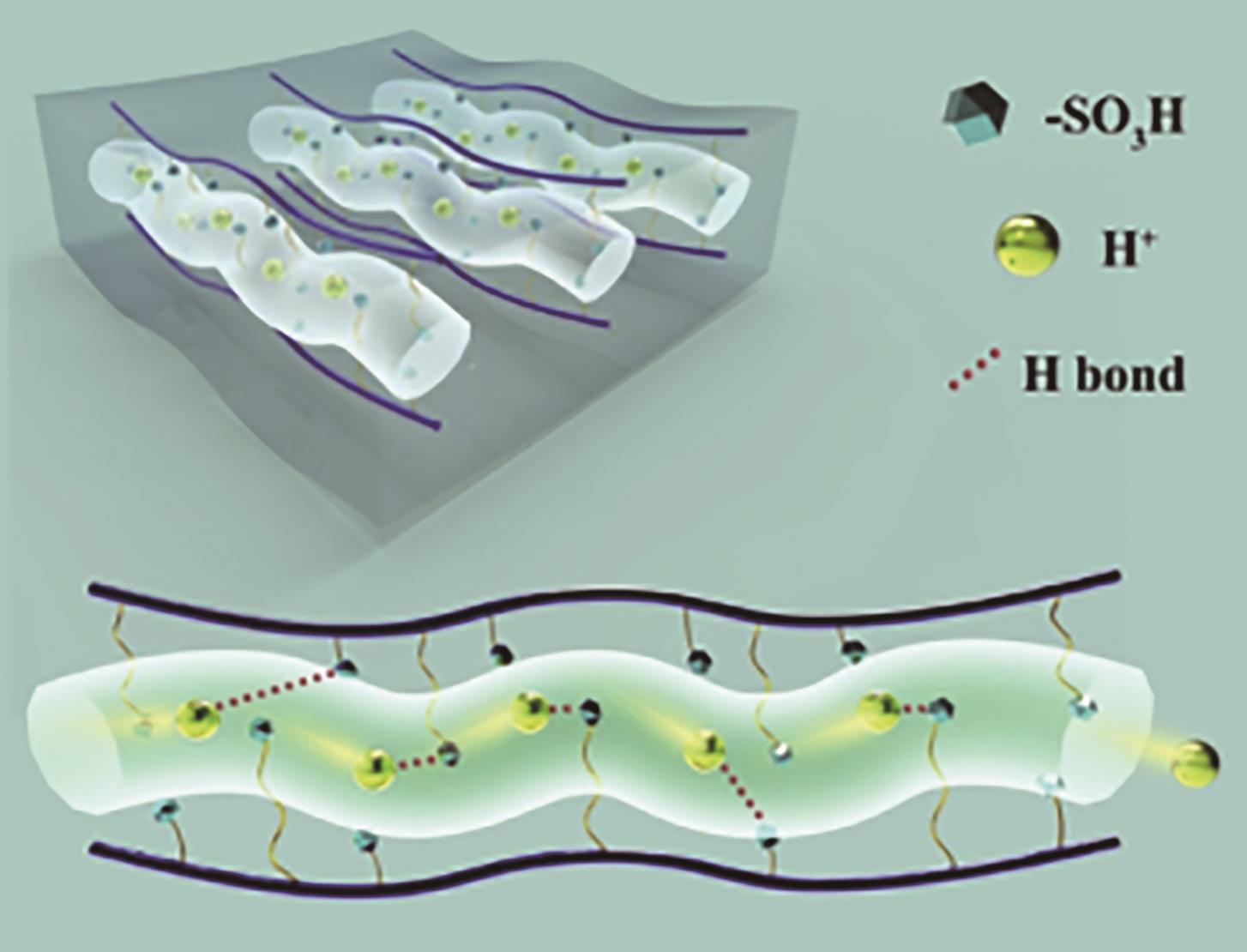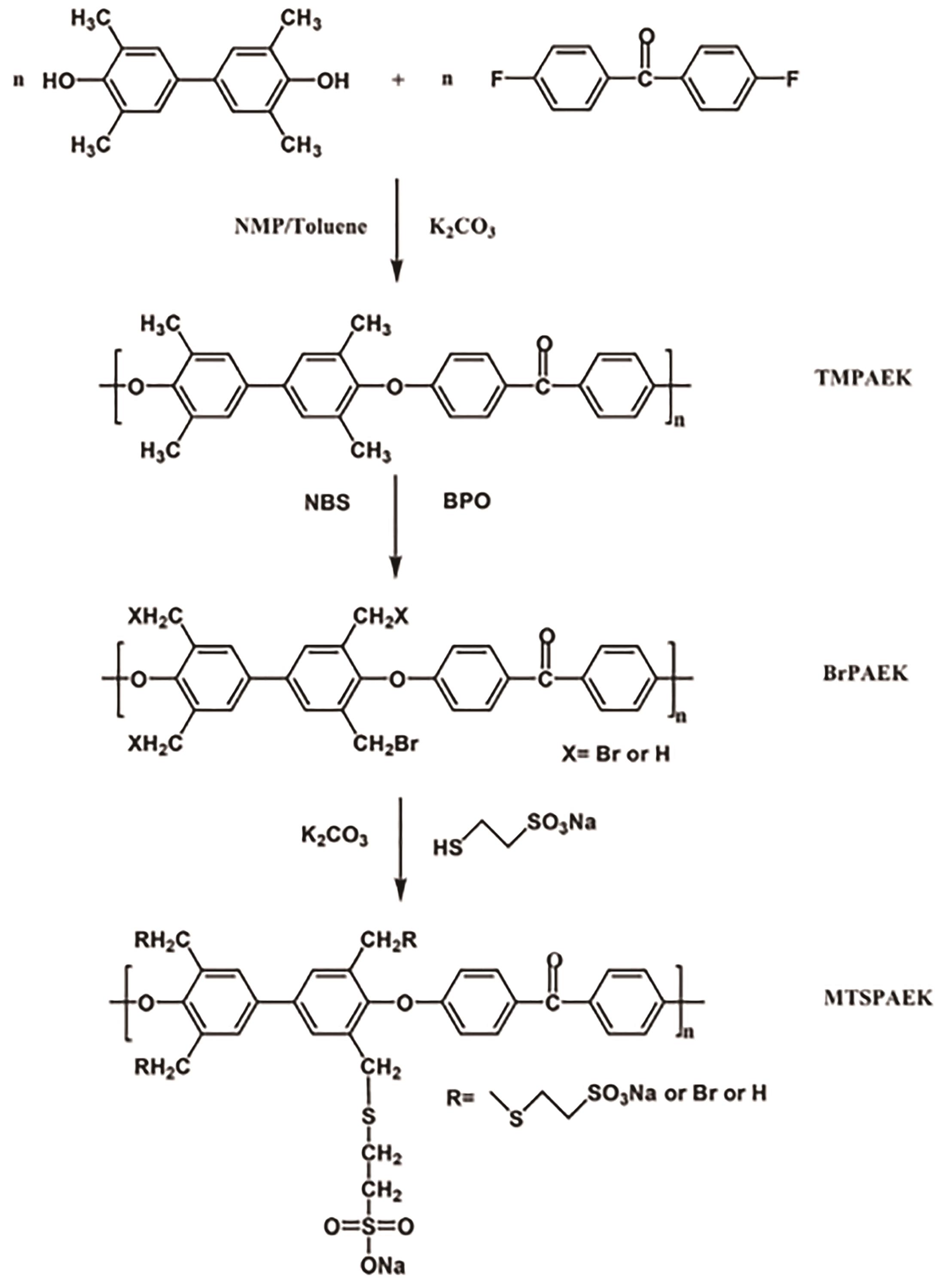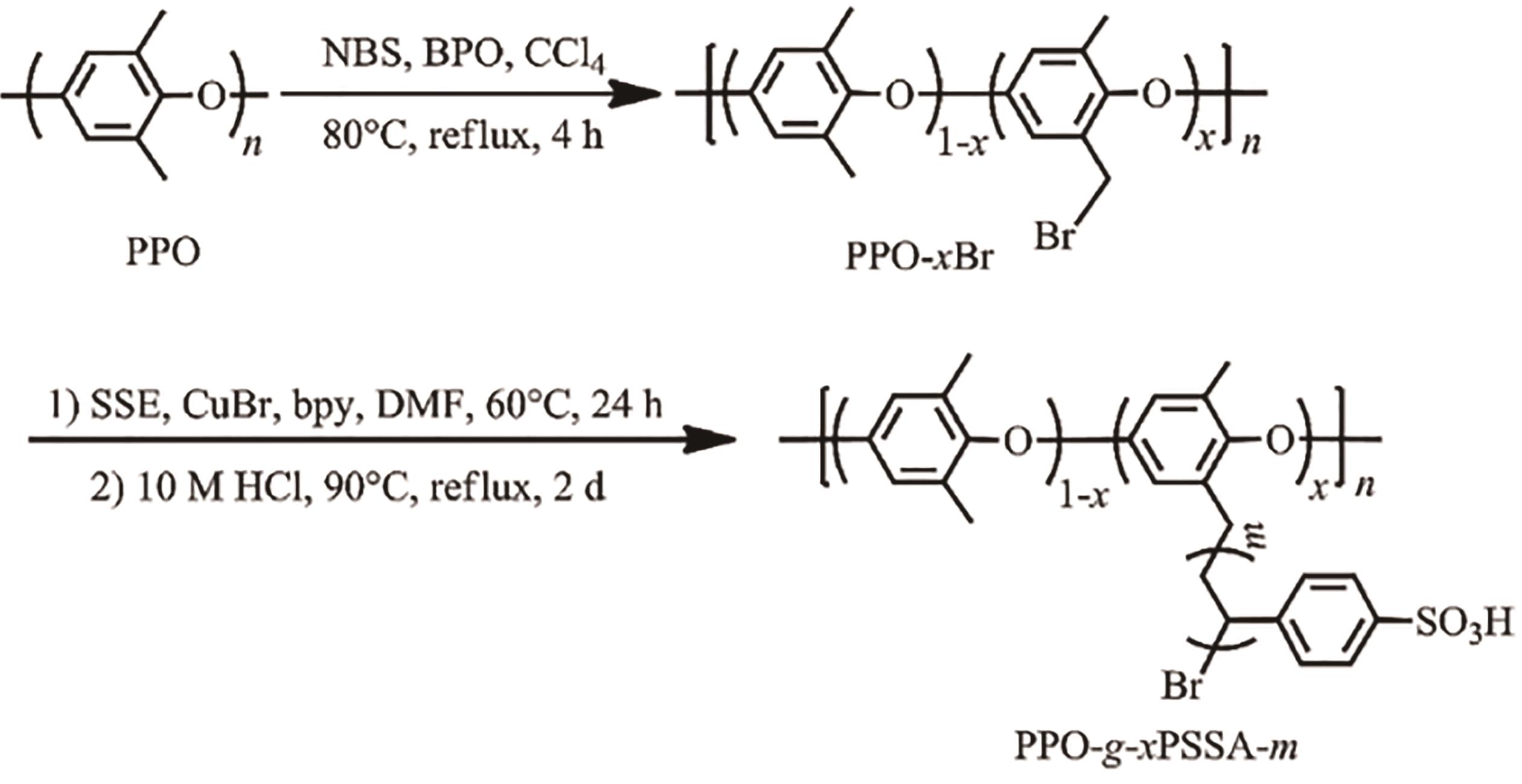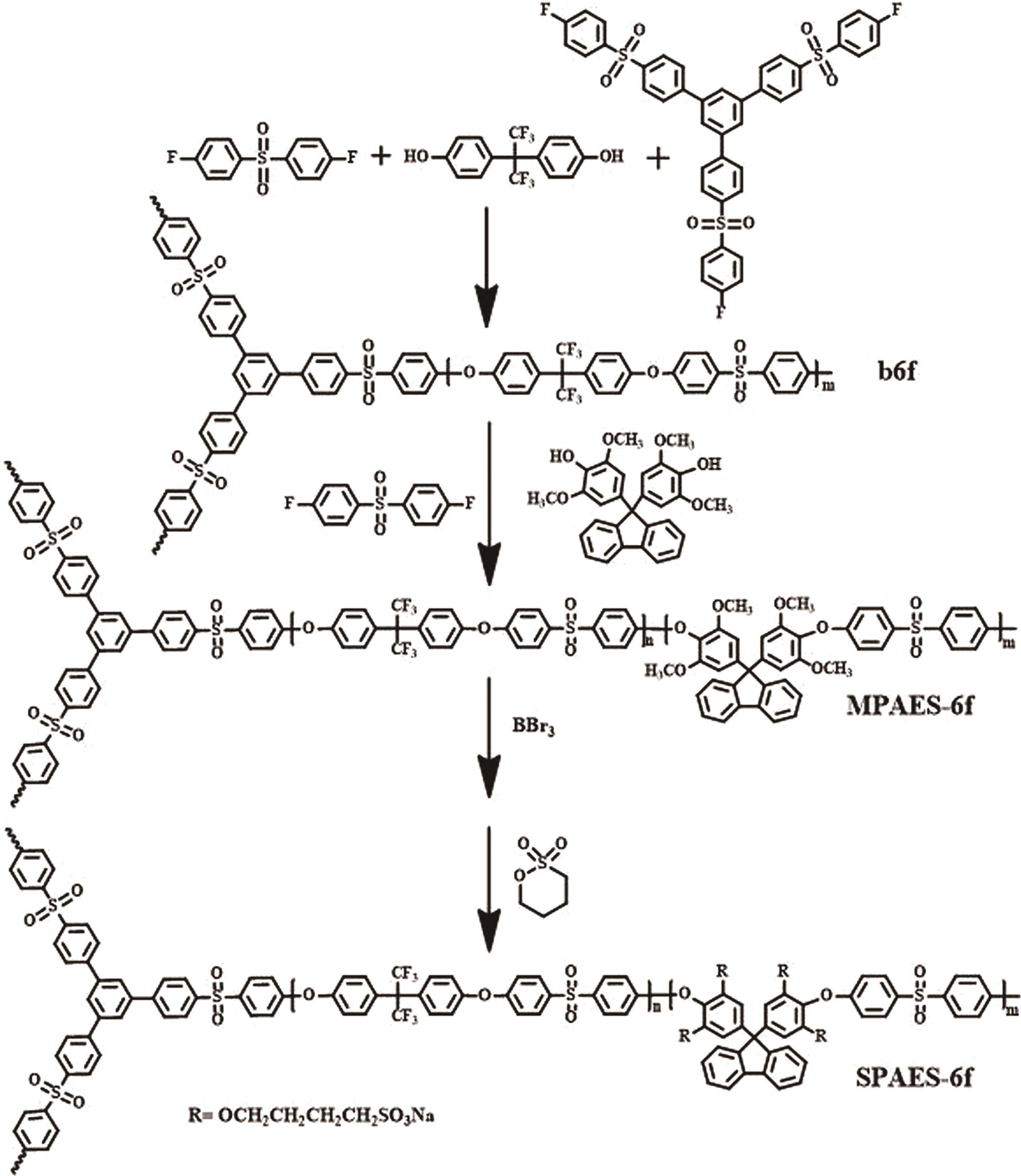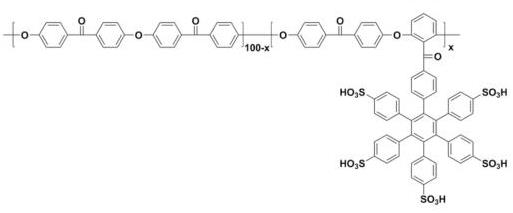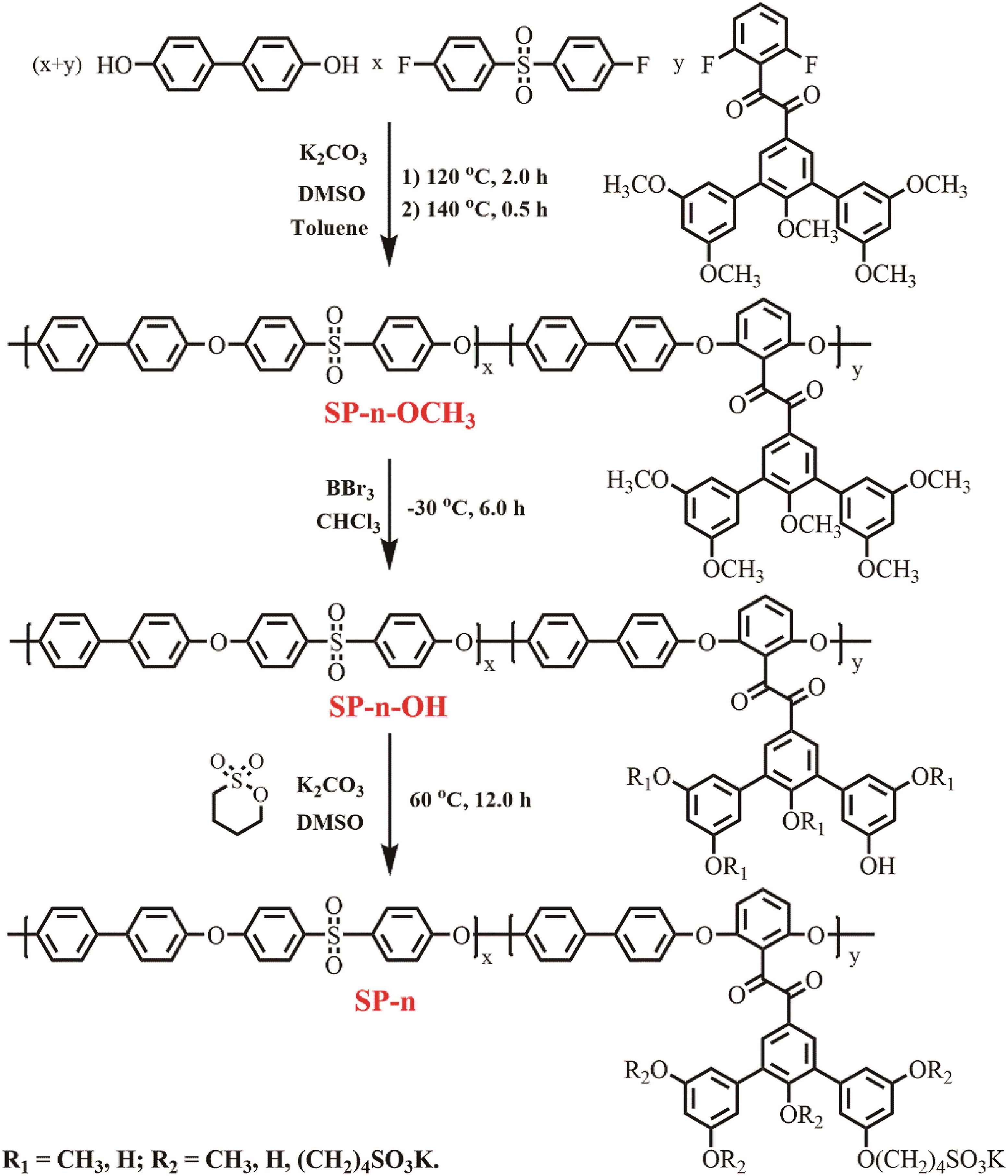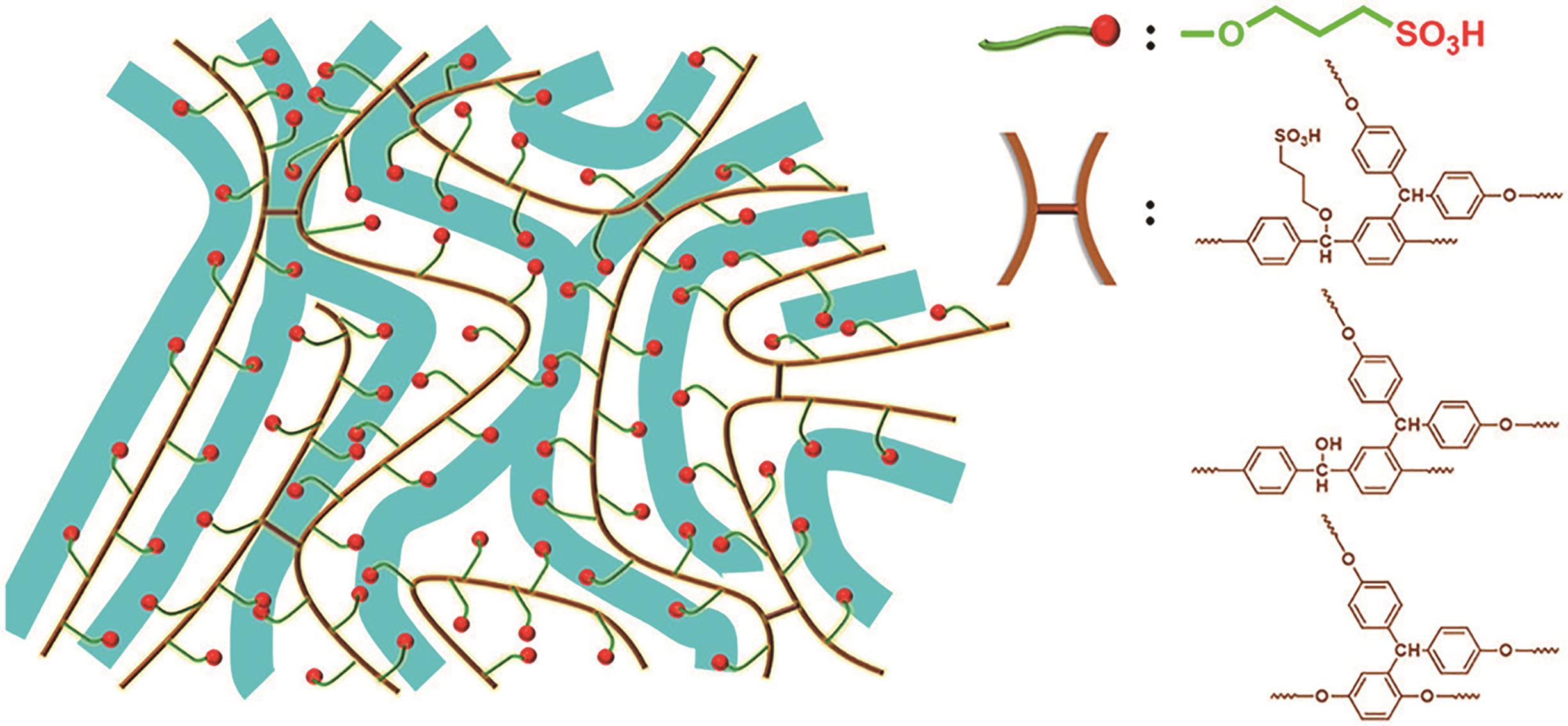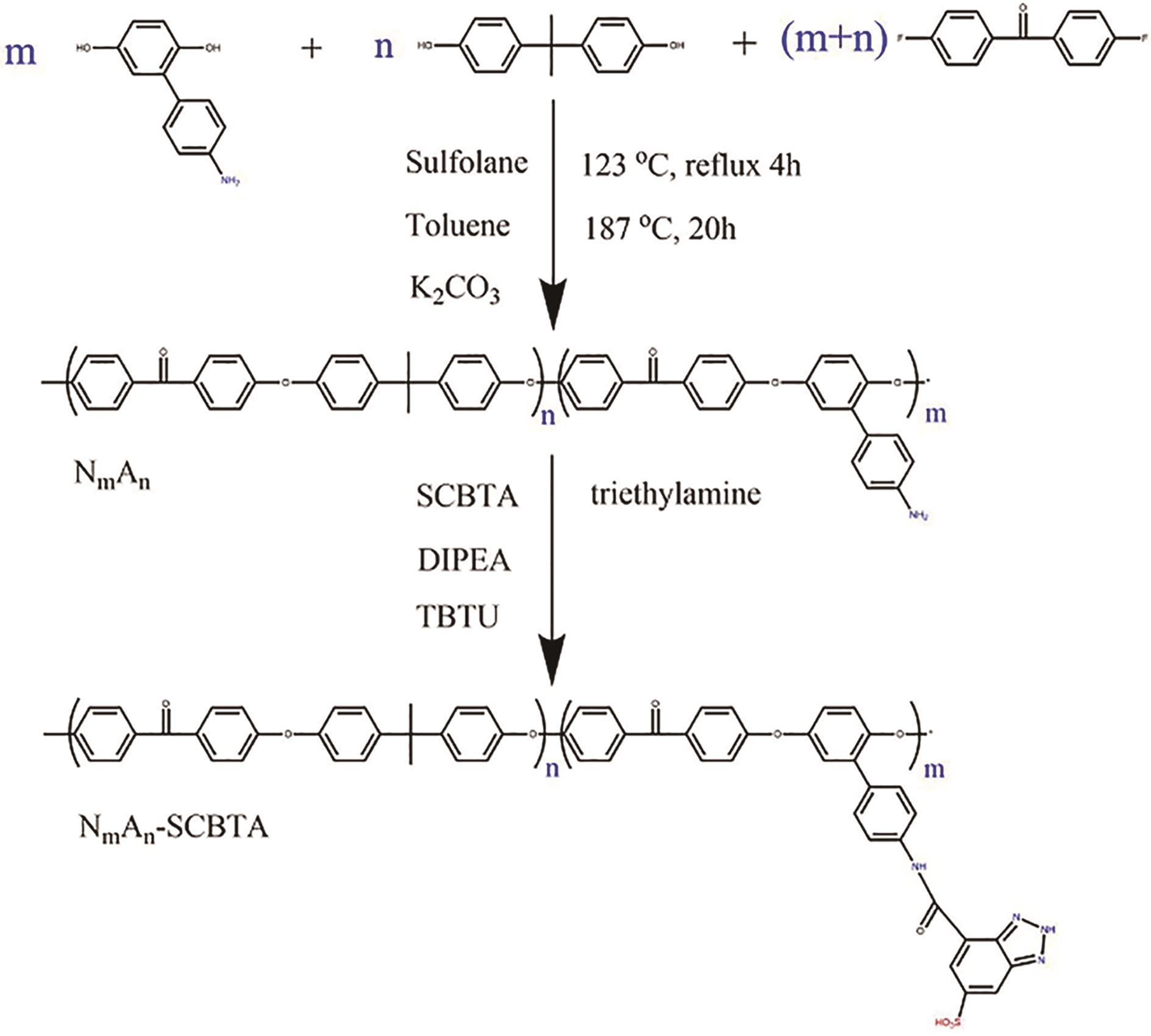
应用化学 ›› 2022, Vol. 39 ›› Issue (12): 1783-1802.DOI: 10.19894/j.issn.1000-0518.220114
• 综合评述 • 下一篇
侧链磺化聚芳醚质子交换膜的研究进展
曹桐1,2, 彭军1,2, 冯炎3, 刘孝波1,2( ), 黄宇敏1,2(
), 黄宇敏1,2( )
)
- 1.电子科技大学材料与能源学院,成都 611731
2.四川省碳氮高分子新材料工程技术研究中心,成都 611731
3.深圳伊腾迪新能源有限公司,深圳 518103
-
收稿日期:2022-04-07接受日期:2022-09-04出版日期:2022-12-01发布日期:2022-12-13 -
通讯作者:刘孝波,黄宇敏 -
基金资助:国家自然科学基金(21805027);四川省科技计划项目(2019YJ0197)
Research Progress of Side-Chain Sulfonated Polyarylene Ether Proton Exchange Membranes
Tong CAO1,2, Jun PENG1,2, Yan FENG3, Xiao-Bo LIU1,2( ), Yu-Min HUANG1,2(
), Yu-Min HUANG1,2( )
)
- 1.School of Materials and Energy,University of Electronic Science and Technology of China,Chengdu 611731,China
2.Sichuan Province Engineering Technology Research Center of Novel CN Polymeric Materials,Chengdu 611731,China
3.Shenzhen Extender Co. ,Ltd,Shenzhen 518103,China
-
Received:2022-04-07Accepted:2022-09-04Published:2022-12-01Online:2022-12-13 -
Contact:Xiao-Bo LIU,Yu-Min HUANG -
About author:hym@uestc.edu.cn
liuxb@uestc.edu.cn
-
Supported by:the National Natural Science Foundation of China(21805027);Sichuan Science and Technology Program(2019YJ0197)
摘要:
燃料电池是以氢气、甲醇等作为燃料的一种新型能量转化装置,其中质子交换膜燃料电池(Proton Exchange Membrane Fuel Cell, PEMFC)凭借其能量功率高、启动速度快和使用寿命长等优点已经在移动电源、潜艇和电动汽车等领域得到了广泛应用。质子交换膜(Proton Exchange Membrane, PEM)对PEMFC的性能影响最大,高效的PEMFC需要PEM具有高的质子电导率、良好的热稳定性和机械性能、低燃料渗透率以及优异的物理化学稳定性等。目前市面上多数使用的均是具有优异质子电导率的Nafion系列膜,但其存在制备困难、成本昂贵、质子电导率严重依赖湿度等缺点,在一定程度上限制了其发展。为了让PEM有更多的选择,科学家一直专注于使用新材料替代Nafion膜。近年来,科学家们模拟Nafion结构,通过合成各种侧链含磺酸基团的聚芳醚结构,使得亲水基团磺酸基和疏水基团之间形成微相分离结构,从而获得了一系列具有优异综合性能的PEM。本文将重点对侧链烷基磺化型、侧链磺化嵌段型、侧链局部密集磺化型、侧链磺化交联型和侧链磺化复合型这几种常见策略的合成方法及性能进行了综述,最后展望了侧链磺化聚芳醚在PEM领域的优势及发展前景。
中图分类号:
引用本文
曹桐, 彭军, 冯炎, 刘孝波, 黄宇敏. 侧链磺化聚芳醚质子交换膜的研究进展[J]. 应用化学, 2022, 39(12): 1783-1802.
Tong CAO, Jun PENG, Yan FENG, Xiao-Bo LIU, Yu-Min HUANG. Research Progress of Side-Chain Sulfonated Polyarylene Ether Proton Exchange Membranes[J]. Chinese Journal of Applied Chemistry, 2022, 39(12): 1783-1802.
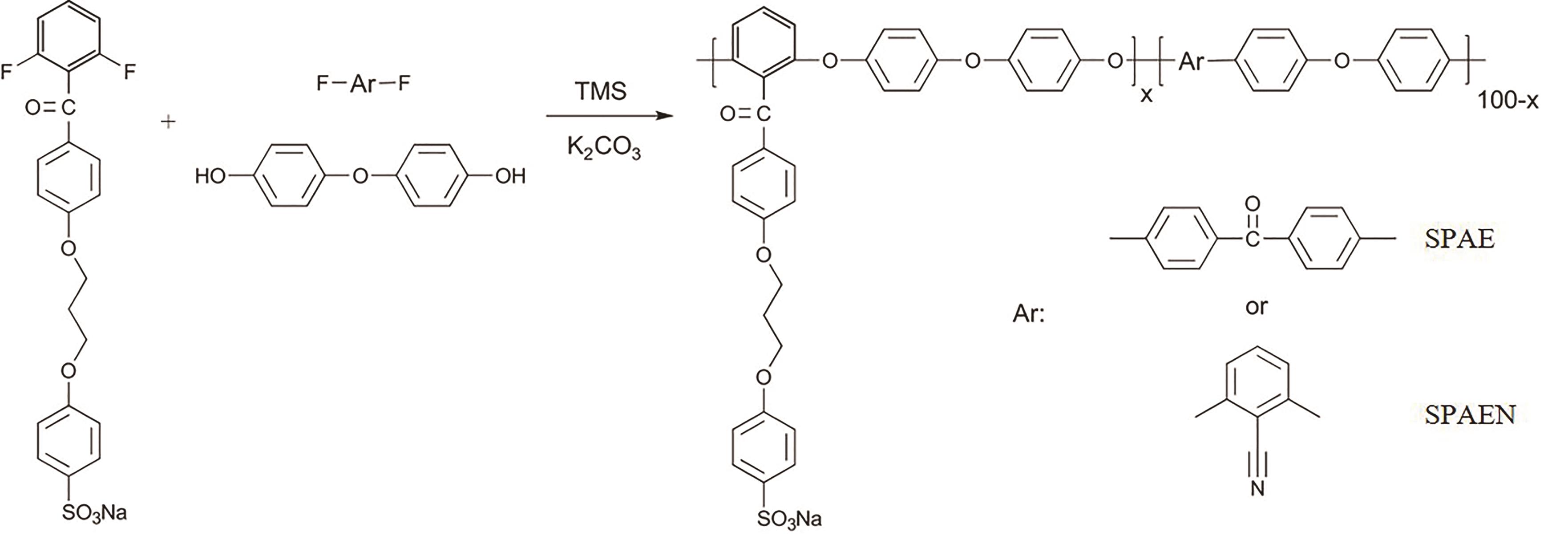
图3 梳形磺化聚芳基醚(Sulfonated poly(arylene ether), SPAE)和磺化聚芳醚腈(Sulfonated poly(arylene ether nitrile), SPAEN)的合成路线[42]
Fig.3 Synthesis route of comb-shaped SPAE and SPAEN[42]

图4 通过TEM研究的SPAE-1,3和SPAEN-1,3聚合物的形态。(A) SPAE-1, DS=0.74; (B) SPAE-3, DS=0.92; (C) SPAEN-1, DS=0.68; (D) SPAEN-3, DS=0.90[42]
Fig.4 Morphology of SPAE-1,3 and SPAEN-1,3 ionomers studied by TEM. (A) SPAE-1, DS=0.74; (B) SPAE-3, DS=0.92; (C) SPAEN-1, DS=0.68; (D) SPAEN-3, DS=0.90[42]

图10 SPARK膜在100%下的AFM相图相对湿度(700 nm×700 nm): (a)SPAEK(X4.8Y8.8)、 (b)SPAEK(X7.5Y8.8)和(c)SPAEK(X9.1Y8.8)[50]
Fig.10 AFM phase image of the SPAEK membranes under 100% RH(700 nm×700 nm): (a) SPAEK (X4.8Y8.8), (b)SPAEK(X7.5Y8.8) and (c) SPAEK (X9.1Y8.8)[50]
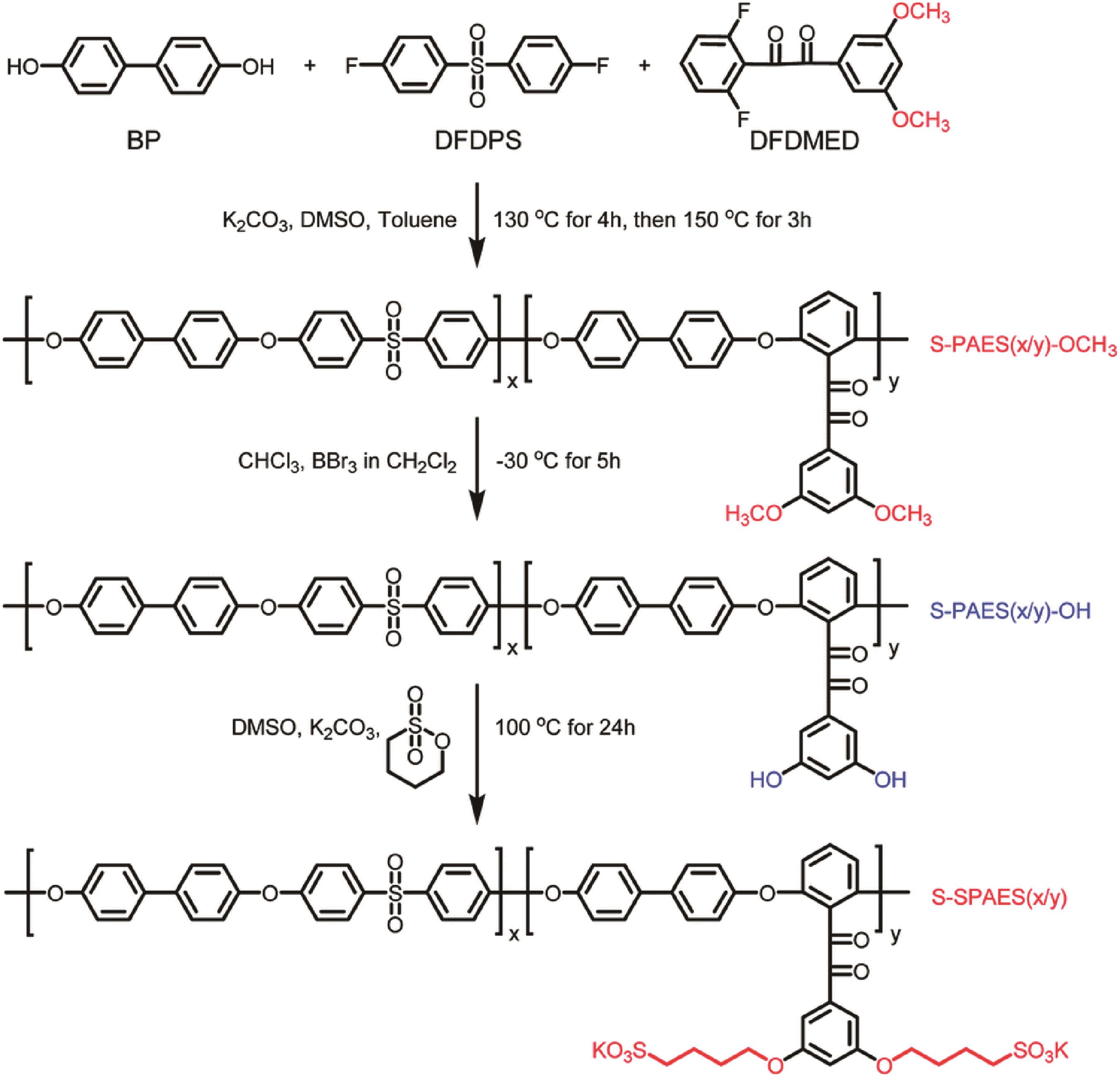
图15 可交联侧链磺化聚芳醚砜共聚物(S-SPAES(x/y))的化学结构[63]
Fig.15 The chemical structure of cross-linkable side chain sulfonated polyarylene ether sulfone copolymer (S-SPAES (x/y))[63]
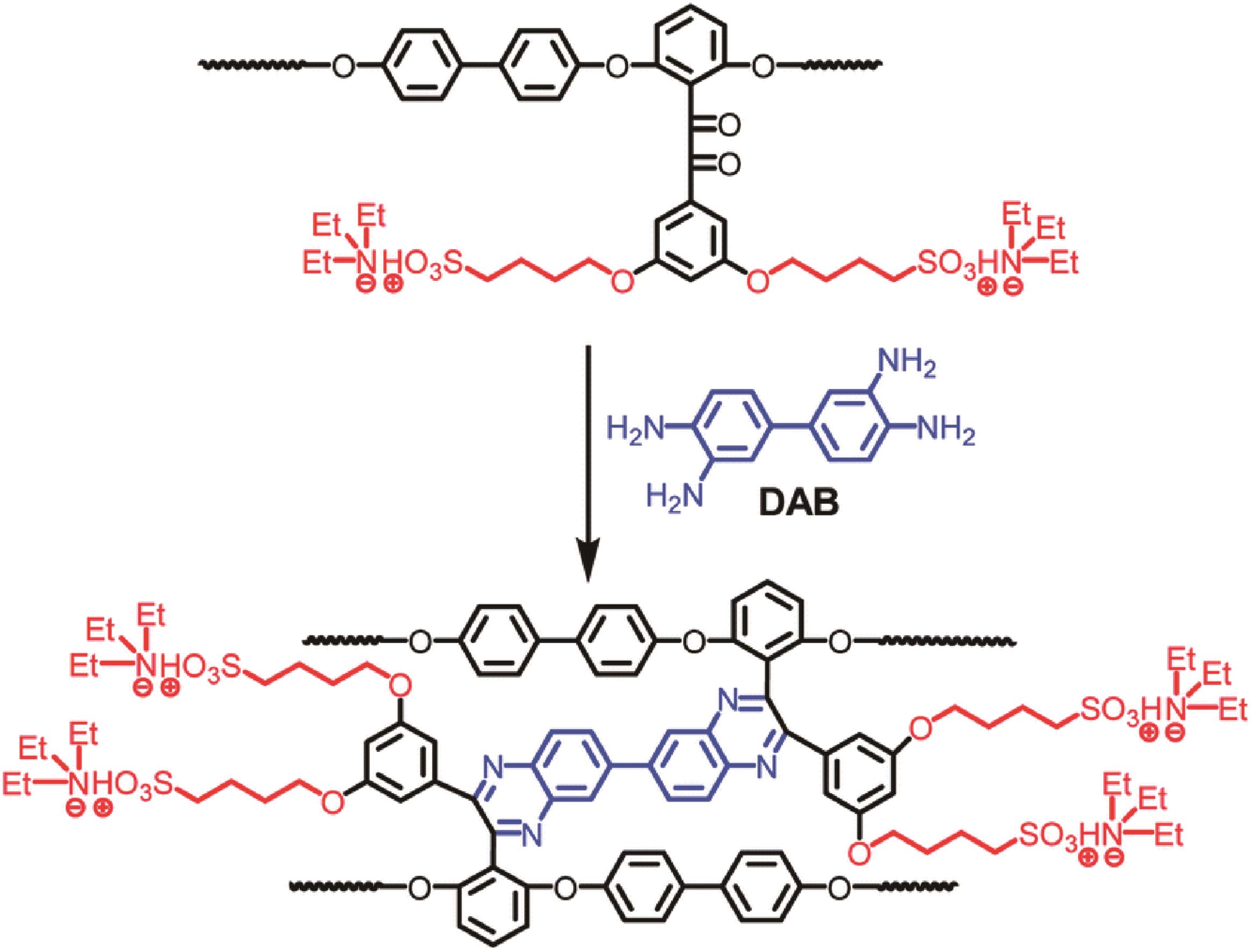
图16 基于S-SPAES(x/y)的铵盐和3,3'-二氨基联苯胺(DAB)交联的化学结构示意图 [63]
Fig.16 Schematic chemical structure based on the cross-linked of ammonium salts of S-SPAES (x/y) and 3,3'-diaminobenzidine[63]
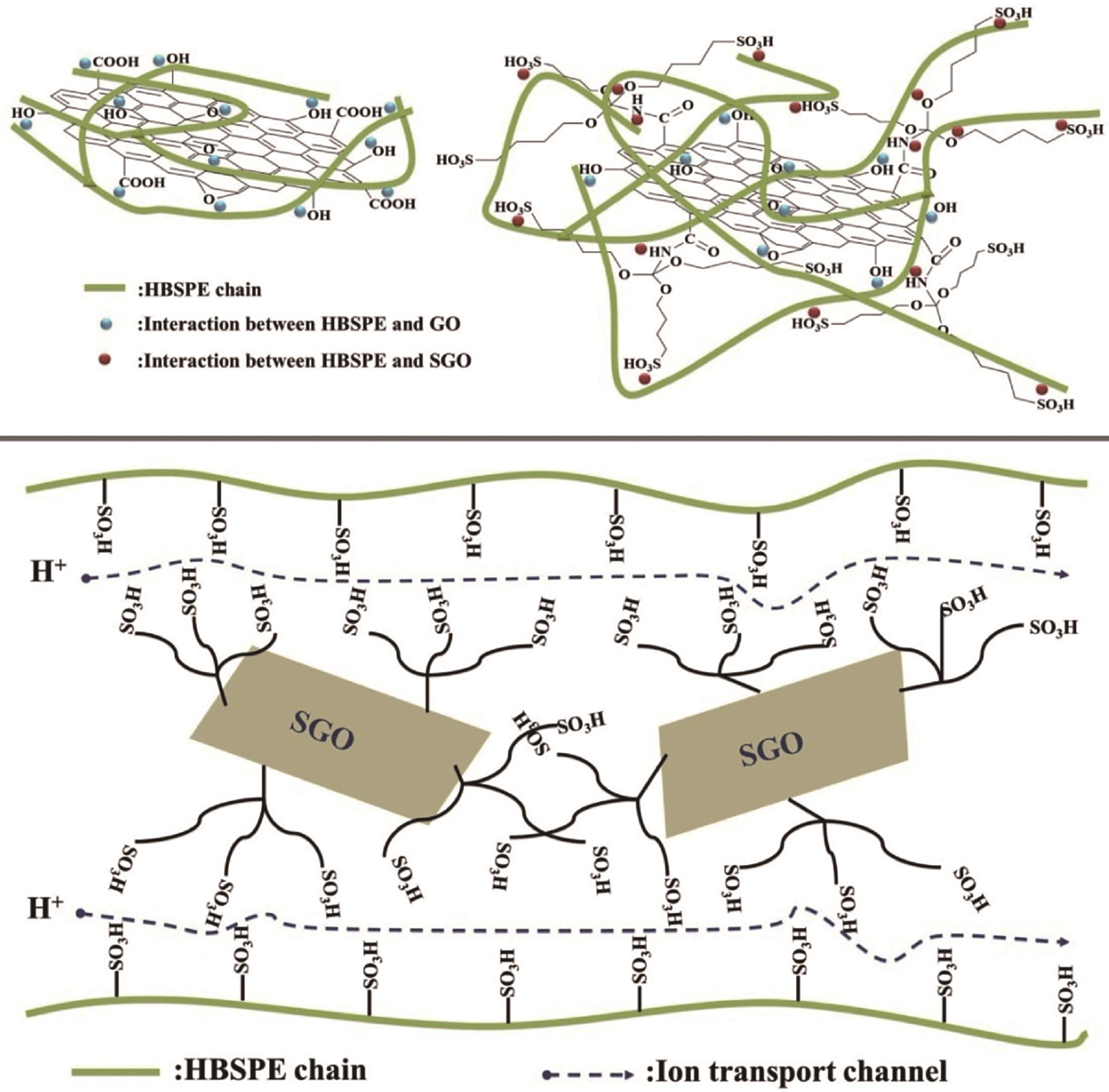
图22 HBSPE与SGO之间的相互作用示意图以及HBSPE/SGO纳米复合膜中的离子通道[72]
Fig.22 Schematic of the interaction between HBSPE and SGO and the ion channel in the HBSPE/SGO nanocomposite membranes[72]
质子交换膜 Proton exchange membrane | 质子电导率 Proton conductivity/ (mS·cm-1) | 离子交换容量 Ion-exchange capacity/ (mmol·g-1) | 吸水率 Water uptake/ % | 燃料电池性能 Fuel cell performance/(mW·cm-2) | 温度 Temperature/ ℃ | 相对湿度 Relative humidity/% | 参考文献 Ref. |
|---|---|---|---|---|---|---|---|
| GSPHP 25 | 102.6 | 1.47 | 60.28 | 620.0 | 80 | 90 | [ |
| PPO-g-0.08PPSA-13 | 45.5 | 3.24 | / | / | 95 | 90 | [ |
SPAEK(X9.1Y8.8) PPEK-M20N10-SO3H | 154.1 150.0 | 2.01 | 70.00 | 323.9 | 60 | 100 | [ |
| 1.41 | 25.60 | 768.0 | 70 | 80 | [ | ||
| SPAES-6f | 420.0 | 1.60 | 59.50 | / | 80 | 100 | [ |
| SPDCP-1.5 | 248.2 | 1.52 | 33.80 | / | 90 | 100 | [ |
| CSP-1 | 215.0 | 1.72 | 27.80 | 1 660.0 | 70 | 65 | [ |
| SPEEK74-O-PA100 | 200.3 | / | 12.60 | 527.0 | 65 | 100 | [ |
| Nafion 211 | 102.8 | 0.90 | 32.13 | 630.0 | 80 | 90 | [ |
| Nafion 115 | 131.5 | 0.92 | 35.00 | 291.4 | 60 | 100 | [ |
| Nafion 212 | 142.0 | 0.91 | 15.40 | 744.0 | 70 | 80 | [ |
表1 本文出现的氢燃料电池PEM主要性能对比
Table 1 Comparison of the main properties of proton exchange membranes based on hydrogen fuel cell appearing in this paper
质子交换膜 Proton exchange membrane | 质子电导率 Proton conductivity/ (mS·cm-1) | 离子交换容量 Ion-exchange capacity/ (mmol·g-1) | 吸水率 Water uptake/ % | 燃料电池性能 Fuel cell performance/(mW·cm-2) | 温度 Temperature/ ℃ | 相对湿度 Relative humidity/% | 参考文献 Ref. |
|---|---|---|---|---|---|---|---|
| GSPHP 25 | 102.6 | 1.47 | 60.28 | 620.0 | 80 | 90 | [ |
| PPO-g-0.08PPSA-13 | 45.5 | 3.24 | / | / | 95 | 90 | [ |
SPAEK(X9.1Y8.8) PPEK-M20N10-SO3H | 154.1 150.0 | 2.01 | 70.00 | 323.9 | 60 | 100 | [ |
| 1.41 | 25.60 | 768.0 | 70 | 80 | [ | ||
| SPAES-6f | 420.0 | 1.60 | 59.50 | / | 80 | 100 | [ |
| SPDCP-1.5 | 248.2 | 1.52 | 33.80 | / | 90 | 100 | [ |
| CSP-1 | 215.0 | 1.72 | 27.80 | 1 660.0 | 70 | 65 | [ |
| SPEEK74-O-PA100 | 200.3 | / | 12.60 | 527.0 | 65 | 100 | [ |
| Nafion 211 | 102.8 | 0.90 | 32.13 | 630.0 | 80 | 90 | [ |
| Nafion 115 | 131.5 | 0.92 | 35.00 | 291.4 | 60 | 100 | [ |
| Nafion 212 | 142.0 | 0.91 | 15.40 | 744.0 | 70 | 80 | [ |
质子交换膜 Proton exchange membrane | 质子电导率 Proton conductivity/ (mS·cm-1) | 离子交换容量 Ion-exchange capacity/ (mmol·g-1) | 吸水率 Water uptake/% | 燃料电池性能 Fuel cell performance/ (mW·cm-2) | 温度 Temperature/ ℃ | 相对湿度 Relative humidity/ % | 甲醇渗透率 Methanol permeability/ (cm2·s-1) | 参考文献 Ref. |
|---|---|---|---|---|---|---|---|---|
| SPAE-3 | 120.0 | 1.50 | 79.60 | / | 100 | 100 | 2.90×10-7 | [ |
SPAEKS-PSA15 MTSPAEK-2.10 | 101.0 181.0 | 0.78 | 15.72 | 30.50 | 80 | 100 | 9.44×10-7 | [ |
| 2.57 | 87.00 | 70.00 | 80 | 100 | 7.80×10-7 | [ | ||
| PEK-SP20 | 100.0 | 1.78 | 34.10 | 45.50 | 80 | 100 | 3.60×10-7 | [ |
| S-SPAES(1/2) | 180.0 | 2.01 | 46.20 | 314.5 | 60 | 100 | 7.12×10-7 | [ |
| N7A3-SCBTA | 89.0 | 1.81 | 20.00 | / | 90 | 100 | 0.79×10-7 | [ |
| MNS@SNF-PAEK-3% | 192.0 | 1.85 | 73.34 | 125.70 | 80 | 100 | 5.28×10-7 | [ |
| HBSPE/SGO 0.50 | 355.0 | 1.74 | 39.00 | 82.36 | 80 | 100 | 7.87×10-7 | [ |
| Nafion117 | 30.2 | 0.80 | 19.60 | 21.30 | 80 | 100 | 1.22×10-6 | [ |
表2 本文出现的甲醇燃料电池PEM主要性能对比
Table 2 Comparison of the main properties of proton exchange membranes based on methanol fuel cell appearing in this paper
质子交换膜 Proton exchange membrane | 质子电导率 Proton conductivity/ (mS·cm-1) | 离子交换容量 Ion-exchange capacity/ (mmol·g-1) | 吸水率 Water uptake/% | 燃料电池性能 Fuel cell performance/ (mW·cm-2) | 温度 Temperature/ ℃ | 相对湿度 Relative humidity/ % | 甲醇渗透率 Methanol permeability/ (cm2·s-1) | 参考文献 Ref. |
|---|---|---|---|---|---|---|---|---|
| SPAE-3 | 120.0 | 1.50 | 79.60 | / | 100 | 100 | 2.90×10-7 | [ |
SPAEKS-PSA15 MTSPAEK-2.10 | 101.0 181.0 | 0.78 | 15.72 | 30.50 | 80 | 100 | 9.44×10-7 | [ |
| 2.57 | 87.00 | 70.00 | 80 | 100 | 7.80×10-7 | [ | ||
| PEK-SP20 | 100.0 | 1.78 | 34.10 | 45.50 | 80 | 100 | 3.60×10-7 | [ |
| S-SPAES(1/2) | 180.0 | 2.01 | 46.20 | 314.5 | 60 | 100 | 7.12×10-7 | [ |
| N7A3-SCBTA | 89.0 | 1.81 | 20.00 | / | 90 | 100 | 0.79×10-7 | [ |
| MNS@SNF-PAEK-3% | 192.0 | 1.85 | 73.34 | 125.70 | 80 | 100 | 5.28×10-7 | [ |
| HBSPE/SGO 0.50 | 355.0 | 1.74 | 39.00 | 82.36 | 80 | 100 | 7.87×10-7 | [ |
| Nafion117 | 30.2 | 0.80 | 19.60 | 21.30 | 80 | 100 | 1.22×10-6 | [ |
| 1 | CAPELLAN-PEREZ I, MEDIAVILLA M, DE CASTRO C, et al. Fossil fuel depletion and socio-economic scenarios: an integrated approach[J]. Energy, 2014, 77: 641-666. |
| 2 | PAN M Z, PAN C J, LI C, et al. A review of membranes in proton exchange membrane fuel cells: transport phenomena, performance and durability[J]. Renew Sust Energ Rev, 2021, 141: 110771. |
| 3 | XING L, SHI W D, SU H N, et al. Membrane electrode assemblies for PEM fuel cells: a review of functional graded design and optimization[J]. Energy, 2019, 177: 445-464. |
| 4 | OGUNGBEMI E, WILBERFORCE T, LJAODOLA O, et al. Selection of proton exchange membrane fuel cell for transportation[J]. Int J Hydrog Energy, 2021, 46(59): 30625-30640. |
| 5 | HAIDER R, WEM Y C, MA Z F, et al. High temperature proton exchange membrane fuel cells: progress in advanced materials and key technologies[J]. Chem Soc Rev, 2021, 50(2): 1138-1187. |
| 6 | WANG Y, DIAR D, CHEN K S, et al. Materials, technological status, and fundamentals of PEM fuel cells-a review[J]. Mater Today, 2020, 32: 178-203. |
| 7 | JIAO K, XUAN J, DU Q, et al. Designing the next generation of proton-exchange membrane fuel cells[J]. Nature, 2021, 595(7867): 361-369. |
| 8 | QU E L, HAO X F, XIAO M, et al. Proton exchange membranes for high temperature proton exchange membrane fuel cells: challenges and perspectives[J]. J Power Sources, 2022, 533: 231386. |
| 9 | LI G Q, KUJAWSKI W, RYNKOWSKA E. Advancements in proton exchange membranes for high-performance high-temperature proton exchange membrane fuel cells (HT-PEMFC)[J]. Rev Chem Eng, 2022, 38(3): 327-346. |
| 10 | CHEN Z C, GUO L, PAN L, et al. Advances in oxygen evolution electrocatalysts for proton exchange membrane water electrolyzers[J]. Adv Energy Mater, 2022, 12(14): 2103670. |
| 11 | LIU Q S, LAN F C, CHEN J Q, et al. A review of proton exchange membrane fuel cell water management: membrane electrode assembly[J]. J Power Sources, 2021, 517: 230723. |
| 12 | LAEDRE S, KONGSTEIN O E, OEDEGAARD A, et al. Materials for proton exchange membrane water electrolyzer bipolar plates[J]. Int J Hydrog Energy, 2017, 42(5): 2713-2723. |
| 13 | SUTRADHAR S C, JANG H, BANIK N, et al. Synthesis and characterization of proton exchange poly(phenylenebenzophenone)s membranes grafted with propane sulfonic acid on pendant phenyl groups[J]. Int J Hydrog Energy, 2017, 42(17): 12749-12758. |
| 14 | WANG G, GUIVER M D. Proton exchange membranes derived from sulfonated polybenzothiazoles containing naphthalene units[J]. J Membr Sci, 2017, 542: 159-167. |
| 15 | HILD S, GUTMANNSBAUER W, LUTH R, et al. A nanoscopic view of structure and deformation of hard elastic polypropylene with scanning force microscopy[J]. J Polym Sci Pol Phys, 1996, 34(12): 1953-1959. |
| 16 | AHMAD H, KAMARUDIN S K, HASRAN U A, et al. Overview of hybrid membranes for direct-methanol fuel-cell applications[J]. Int J Hydrog Energy, 2010, 35(5): 2160-2175. |
| 17 | DEVANATHAN R. Recent developments in proton exchange membranes for fuel cells[J]. Energy Environ Sci, 2008, 1(1): 101-119. |
| 18 | DUPUIS A C. Proton exchange membranes for fuel cells operated at medium temperatures: materials and experimental techniques[J]. Prog Mater Sci, 2011, 56(3): 289-327. |
| 19 | ELABD Y A, HICKNER M A. Block copolymers for fuel cells[J]. Macromolecules, 2011, 44(1): 1-11. |
| 20 | KREUER K D. On the development of proton conducting polymer membranes for hydrogen and methanol fuel cells[J]. J Membr Sci, 2001, 185(1): 29-39. |
| 21 | MIYATAKE K, IYOTANI H, YAMAMOTO K, et al. Synthesis of poly(phenylene sulfide sulfonic acid) via poly(sulfonium cation) as a thermostable proton-conducting polymer[J]. Macromolecules, 1996, 29(21): 6969-6971. |
| 22 | PARK C H, LEE C H, GUIVER M D, et al. Sulfonated hydrocarbon membranes for medium-temperature and low-humidity proton exchange membrane fuel cells (PEMFCs)[J]. Prog Polym Sci, 2011, 36(11): 1443-1498. |
| 23 | XU T W, WU D, WU L. Poly(2,6-dimethyl-1,4-phenylene oxide) (PPO)-a versatile starting polymer for proton conductive membranes (PCMs)[J]. Prog Polym Sci, 2008, 33(9): 894-915. |
| 24 | INZELT G, PINERI M, SCHULTZE J W, et al. Electron and proton conducting polymers: recent developments and prospects[J]. Electrochim Acta, 2000, 45(15/16): 2403-2421. |
| 25 | DU N Y, ROBERTSON G P, PINNAU I, et al. Polymers of intrinsic microporosity with dinaphthyl and thianthrene segments[J]. Macromolecules, 2010, 43(20): 8580-8587. |
| 26 | FUJIMOTO C H, HICKNER M A, CORNELIUS C J, et al. Ionomeric poly(phenylene) prepared by diels-alder polymerization: synthesis and physical properties of a novel polyelectrolyte[J]. Macromolecules, 2005, 38(12): 5010-5016. |
| 27 | LIU B J, ROBERTSON G P, KIM D S, et al. Aromatic poly(ether ketone)s with pendant sulfonic acid phenyl groups prepared by a mild sulfonation method for proton exchange membranes[J]. Macromolecules, 2007, 40(6): 1934-1944. |
| 28 | MIYATAKE K, OYAIZU K, TSUCHIDA E, et al. Synthesis and properties of novel sulfonated arylene ether/fluorinated alkane copolymers[J]. Macromolecules, 2001, 34(7): 2065-2071. |
| 29 | SEESUKPHRONRARAK S, OHIRA K, KIDENA K, et al. Synthesis and properties of sulfonated copoly(p-phenylene)s containing aliphatic alkyl pendant for fuel cell applications[J]. Polymer, 2010, 51(3): 623-631. |
| 30 | 乔宗文, 陈涛. 燃料电池用侧链型磺化聚砜质子交换膜的性能[J]. 应用化学, 2019, 36(8): 917-923. |
| QIAO Z W CHEN T. Properties of side chain type sulfonated polysulfone proton exchange membranes for fuel cells[J]. Chinese J Appl Chem, 2019, 36(8): 917-923. | |
| 31 | KREUER K, ALBRECHT R, WERNER W, et al. Vehicle mechanism, a new model for the interpretation of the conductivity of fast proton conductors[J]. Angew Chem Int Ed, 1982, 21(3): 208-209. |
| 32 | KREUER K D, PADDISON S J, SPOHR E, et al. Transport in proton conductors for fuel-cell applications: simulations, elementary reactions, and phenomenology[J]. Chem Rev, 2004, 104(10): 4637-4678. |
| 33 | JIN C H, ZHU X L, ZHANG S, et al. Highly conductive flexible alkylsulfonated side chains poly(phthalazinone ether ketone)s for proton exchange membranes[J]. Polymer, 2018, 148: 269-277. |
| 34 | LI J L, BU F Z, RU C Y, et al. Enhancing the selectivity of Nafion membrane by incorporating a novel functional skeleton molecule to improve the performance of direct methanol fuel cells[J]. J Mater Chem A, 2020, 8(1): 196-206. |
| 35 | LIM Y, SEO D, HOSSAIN M A, et al. Preparation and characterization of proton exchange poly(ether sulfone)s membranes grafted propane sulfonic acid on pendant phenyl groups[J]. Electrochim Acta, 2014, 118: 18-25. |
| 36 | LIU D J, ZHONG H Y, WANG G Q, et al. Nonparaxial propagation of a partially coherent four-petal Gaussian vortex beam[J]. Optik, 2018, 158: 451-459. |
| 37 | WANG C Y, LEE S Y, SHIN D W, et al. Proton-conducting membranes from poly(ether sulfone)s grafted with sulfoalkylamine[J]. J Membr Sci, 2013, 427: 443-450. |
| 38 | LEE S Y, SHIN D W, WANG C, et al. A capillary water retention effect to improve medium-temperature fuel cell performance[J]. Electrochem Commun, 2013, 31: 120-124. |
| 39 | PANG J H, ZHANG H B, JIANG Z H, et al. Novel wholly aromatic sulfonated poly(arylene ether) copolymers containing sulfonic acid groups on the pendants for proton exchange membrane materials[J]. Macromolecules, 2007, 40(26): 9435-9442. |
| 40 | PANG J H, ZHANG H B, LI X F, et al. Low water swelling and high proton conducting sulfonated poly(arylene ether) with pendant sulfoalkyl groups for proton exchange membranes[J]. Macromol Rapid Commun, 2007, 28(24): 2332-2338. |
| 41 | PANG J H, LIU B J, JIANG Z H, et al. Synthesis and characterization of sulfonated poly(arylene ether)s with sulfoalkyl pendant groups for proton exchange membranes[J]. J Membr Sci, 2008, 318(1/2): 271-279. |
| 42 | ZHANG Q, LIU B J, HU W, et al. Poly(arylene ether) electrolyte membranes bearing aliphatic-chain-linked sulfophenyl pendant groups[J]. J Membr Sci, 2013, 428: 629-638. |
| 43 | LIU C, WANG X, XU J M, et al. PEMs with high proton conductivity and excellent methanol resistance based on sulfonated poly(aryl ether ketone sulfone) containing comb-shaped structures for DMFCs applications[J]. Int J Hydrog Energy, 2020, 45(1): 945-957. |
| 44 | LI X F, BU F Z, ZHANG H Q, et al. Facile synthesis of poly (arylene ether ketone)s containing flexible sulfoalkyl groups with enhanced oxidative stability for DMFCs[J]. Int J Hydrog Energy, 2020, 45(51): 27632-27643. |
| 45 | ZENG G B, ZHANG D Q, YAN L M, et al. Design and synthesis of side-chain optimized poly(2,6-dimethyl-1,4-phenylene oxide)-g-poly(styrene sulfonic acid) as proton exchange membrane for fuel cell applications: balancing the water-resistance and the sulfonation degree[J]. Int J Hydrog Energy, 2021, 46(39): 20664-20677. |
| 46 | KHOMEIN P, KETELAARS W, LAP T, et al. Sulfonated aromatic polymer as a future proton exchange membrane: a review of sulfonation and crosslinking methods[J]. Renew Sust Energ Rev, 2021, 137: 110471. |
| 47 | ROY A, HICKNER M A, YU X, et al. Influence of chemical composition and sequence length on the transport properties of proton exchange membranes[J]. J Polym Sci Pol Phys, 2006, 44(16): 2226-2239. |
| 48 | 毕伟辉, 郑吉富, 张所波. 磺化聚苯醚酮质子交换膜的制备与表征[J]. 应用化学, 2017, 34(10): 1117-1126. |
| BI W H, ZHENG J F, ZHANG S B. Preparation and characterization of sulfonated poly(p-phenylene-co-aryl ether ketone) for proton exchange membranes[J]. Chinese J Appl Chem, 2017, 34(10): 1117-1126. | |
| 49 | MEIER-HAACK J, TAEGER A, VOGEL C, et al. Membranes from sulfonated block copolymers for use in fuel cells[J]. Sep Purif Technol, 2005, 41(3): 207-220. |
| 50 | LEE K H, CHU J Y, KIM A R, et al. Enhanced performance of a sulfonated poly(arylene ether ketone) block copolymer bearing pendant sulfonic acid groups for polymer electrolyte membrane fuel cells operating at 80% relative humidity[J]. ACS Appl Mater Interfaces, 2018, 10(24): 20835-20844. |
| 51 | DONG T D, HU J H, UEDA M, et al. Enhanced proton conductivity of multiblock poly(phenylene ether ketone)s via pendant sulfoalkoxyl side chains with excellent H-2/air fuel cell performance[J]. J Mater Chem A, 2016, 4(6): 2321-2331. |
| 52 | XIE H X, TAO D, NI J P, et al. Synthesis and properties of highly branched star-shaped sulfonated block polymers with sulfoalkyl pendant groups for use as proton exchange membranes[J]. J Membr Sci, 2016, 497: 55-66. |
| 53 | SEO D W, LIM Y D, LEE S H, et al. Preparation and characterization of sulfonated poly(tetra phenyl ether ketone sulfone)s for proton exchange membrane fuel cell[J]. Int J Hydrog Energy, 2012, 37(7): 6140-6147. |
| 54 | BOSE S, KUILA T, NGUYEN T, et al. Polymer membranes for high temperature proton exchange membrane fuel cell: recent advances and challenges[J]. Prog Polym Sci, 2011, 36(6): 813-843. |
| 55 | LIU D, DONG B, ZHANG H B, et al. High methanol resistant polyelectrolyte membrane based on semi-crystalline poly(ether ketone) with densely sulfonated side chain for direct methanol fuel cell[J]. J Power Sources, 2021, 482: 228982. |
| 56 | KERRES J, ULLRICH A, MEIER F, et al. Synthesis and characterization of novel acid-base polymer blends for application in membrane fuel cells[J]. Solid State Ion, 1999, 125(1/2/3/4): 243-249. |
| 57 | GU S, HE G H, WU X M, et al. Preparation and characteristics of crosslinked sulfonated poly(phthalazinone ether sulfone ketone) with poly(vinyl alcohol) for proton exchange membrane[J]. J Membr Sci, 2008, 312(1/2): 48-58. |
| 58 | MIKHAILENKO S U D, WANG K P, KALIAGUINE S, et al. Proton conducting membranes based on cross-linked sulfonated poly(ether ether ketone) (SPEEK)[J]. J Membr Sci, 2004, 233(1/2): 93-99. |
| 59 | FANG J H, ZHAI F X, GUO X X, et al. A facile approach for the preparation of cross-linked sulfonated polyimide membranes for fuel cell application[J]. J Mater Chem, 2007, 17(11): 1102-1108. |
| 60 | DING F C, WANG S J, XIAO M, et al. Cross-linked sulfonated poly(phathalazinone ether ketone)s for PEM fuel cell application as proton-exchange membrane[J]. J Power Sources, 2007, 164(2): 488-495. |
| 61 | ZHONG S L, CUI X J, CAI H L, et al. Crosslinked sulfonated poly(ether ether ketone) proton exchange membranes for direct methanol fuel cell applications[J]. J Power Sources, 2007, 164(1): 65-72. |
| 62 | FENG S G, SHANG Y M, XIE X F, et al. Synthesis and characterization of crosslinked sulfonated poly(arylene ether sulfone) membranes for DMFC applications[J]. J Membr Sci, 2009, 335(1/2): 13-20. |
| 63 | WANG S P, HE F G, WENG Q, et al. Synthesis and characterization of a novel crosslinkable side-chain sulfonated poly(arylene ether sulfone) copolymer proton exchange membranes[J]. RSC Adv, 2020, 10(42): 24772-24783. |
| 64 | YUAN D, QIN Y, LI S, et al. Improved performance of novel sulfonated poly(arylene ether sulfone) copolymer via tethering densely sulfonated pendant groups[J]. J Power Sources, 2021, 484: 229265. |
| 65 | LI W H, JIANG J J, AN H L, et al. Self-cross-linked sulfonated poly(ether ether ketone) with pendant sulfoalkoxy groups for proton exchange membrane fuel cells[J]. ACS Appl Energ Mater, 2021, 4(3): 2732-2740. |
| 66 | LIU W C, WANG Z, DU X M, et al. Poly(arylene ether ketone) with an ultrahigh-selectivity hydrophilic phase proton transport channel by grafting sulfonated benzotriazole groups onto pendant chains[J]. ACS Sustain Chem Eng, 2020, 8(16): 6505-6516. |
| 67 | SUBIANTO S, MISTRY M K, CHOUDHURY N R, et al. Composite polymer electrolyte containing ionic liquid and functionalized polyhedral oligomeric silsesquioxanes for anhydrous PEM applications[J]. ACS Appl Mater Interfaces, 2009, 1(6): 1173-1182. |
| 68 | CHOI B G, HONG J, PARK Y C, et al. Innovative polymer nanocomposite electrolytes: nanoscale manipulation of ion channels by functionalized graphenes[J]. ACS Nano, 2011, 5(6): 5167-5174. |
| 69 | YANG L J, TANG B B, WU P Y. Metal-organic framework-graphene oxide composites: a facile method to highly improve the proton conductivity of PEMs operated under low humidity[J]. J Mater Chem A, 2015, 3(31): 15838-15842. |
| 70 | WANG L, YI B L, ZHANG H M, et al. Characteristics of polyethersulfone/sulfonated polyimide blend membrane for proton exchange membrane fuel cell[J]. J Phys Chem B, 2008, 112(14): 4270-4275. |
| 71 | RU C, LI Z, ZHAO C, et al. Enhanced proton conductivity of sulfonated hybrid poly(arylene ether ketone) membranes by incorporating an amino-sulfo bifunctionalized metal-organic framework for direct methanol fuel cells[J]. ACS Appl Mater Interfaces, 2018, 10(9): 7963-7963. |
| 72 | LIU D, PENG J H, LI Z Y, et al. Improvement in the mechanical properties, proton conductivity, and methanol resistance of highly branched sulfonated poly(arylene ether)/graphene oxide grafted with flexible alkylsulfonated side chains nanocomposite membranes[J]. J Power Sources, 2018, 378: 451-459. |
| 73 | DUTTA K, DAS S, KUNDU P P. Partially sulfonated polyaniline induced high ion-exchange capacity and selectivity of Nafion membrane for application in direct methanol fuel cells[J]. J Menbr Sci, 2014, 473: 94-101. |
| [1] | 王显, 杨小龙, 马荣鹏, 刘长鹏, 葛君杰, 邢巍. 单原子分散的Ir-N-C燃料电池阳极抗中毒催化剂[J]. 应用化学, 2022, 39(8): 1202-1208. |
| [2] | 孟玉, 张晴, 彭文浩, 朱晓飞, 周德凤. Pr0.8Sr0.2Fe0.7Ni0.3O3-δ -Pr1.2Sr0.8Ni0.6Fe0.4O4+δ 复合阴极的制备及其电化学性能[J]. 应用化学, 2022, 39(5): 797-808. |
| [3] | 王雪, 王意波, 王显, 祝建兵, 葛君杰, 刘长鹏, 邢巍. 酸性电解水过程中氧析出反应的机理及铱基催化剂的研究进展[J]. 应用化学, 2022, 39(4): 616-628. |
| [4] | 唐雅薇, 徐兰兰, 刘孝娟. Co、Ni、Fe掺杂有效提升PrBaMn2O5+δ 阳极材料的催化活性[J]. 应用化学, 2022, 39(10): 1543-1553. |
| [5] | 李宫, 金龙一, 姚鹏飞, 刘聪, 徐维林. 介孔炭负载铂纳米粒子的高效氧还原催化剂的可控设计[J]. 应用化学, 2021, 38(12): 1639-1646. |
| [6] | 宋勋, 贾玉婷, 张睫灵, 宁金凤, 左海燕, 黄雪红. 磺化双酚芴型聚醚醚酮质子交换膜的制备及其在钒流电池中的应用[J]. 应用化学, 2020, 37(8): 912-922. |
| [7] | 魏振业, 孟君玲, 王浩聪, 张文文, 刘孝娟, 孟健. 同型异质表面修饰提高La2NiO4+δ阴极的电催化活性[J]. 应用化学, 2020, 37(8): 939-951. |
| [8] | 付凤艳,程敬泉. 静电纺丝纳米纤维在燃料电池质子交换膜中应用的研究进展[J]. 应用化学, 2020, 37(4): 405-415. |
| [9] | 刘世伟, 梁亮, 李晨阳, 刘长鹏, 邢巍, 董献堆. 高温质子交换膜燃料电池的复合催化层电极[J]. 应用化学, 2019, 36(9): 1085-1090. |
| [10] | 乔宗文, 陈涛. 燃料电池用侧链型磺化聚砜质子交换膜的性能[J]. 应用化学, 2019, 36(8): 917-923. |
| [11] | 于彦存,王显,葛君杰,刘长鹏,邢巍. 聚吡咯改性炭载Pd催化剂促进甲酸电氧化[J]. 应用化学, 2019, 36(11): 1317-1322. |
| [12] | 邓光荣, 梁亮, 李晨阳, 刘长鹏, 葛君杰, 邢巍. 直接甲醇燃料电池甲醇传质过程分析及浓度控制策略[J]. 应用化学, 2019, 36(10): 1211-1220. |
| [13] | 毕伟辉, 郑吉富, 张所波. 磺化聚苯醚酮质子交换膜的制备与表征[J]. 应用化学, 2017, 34(10): 1117-1126. |
| [14] | 黄火娣,张晓凤,张艺,乐丽娟,林深. 铂/{还原氧化石墨烯/硅钨酸盐}n复合物的制备及其电催化性能[J]. 应用化学, 2017, 34(10): 1209-1220. |
| [15] | 毕伟辉, 郑吉富, 张所波. 磺化聚苯醚酮质子交换膜的制备与表征[J]. 应用化学, 2017, 34(10): 0-0. |
| 阅读次数 | ||||||
|
全文 |
|
|||||
|
摘要 |
|
|||||
